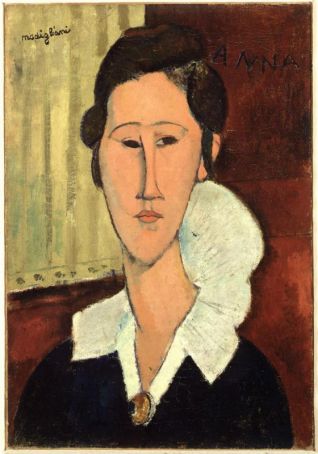Portrait of Hanka Zborowska by Amedeo Modigliani is on permanent display at Italy's National Gallery of Modern Art in Rome.
This work by Italian painter and sculptor Amedeo Modigliani (1884-1920) is among the first in a series of nine surviving portraits he created of Anna (Hanka) Zborowska between 1916 and 1919.
Who was Hanka Zborowska
A member of a Polish aristocratic family, Hanka Cirowska married the poet Léopold Zborowski, also from Poland, soon after his arrival in Paris in 1914.
Within a couple of years her husband became Modigliani’s art dealer, and the two men developed a close rapport, in both a professional and personal capacity.
Madame Zborowska
This was in contrast to Modigliani’s formal relationship with the refined but reserved Hanka, whom he addressed as Madame Zborowska.
Although she did not approve of his wildly bohemian lifestyle, she tolerated his behaviour and posed regularly (always fully clothed) as she recognised his genius and also realised that Modigliani’s creative output was crucial to the success of her husband’s career.
Lady with a collar
The canvas was completed in 1917, just three years before the artist’s tragic death, aged 35, in Paris.
Known also as the Lady with a collar, the work has echoes of 14th century Sienese painting, with its elongated face and neck, a sculptural style which Modigliani made all his own.
"Anna"
With the exception of her fanned-out high white collar and amber brooch at the base of her swan neck, there is little decoration to distract from Hanka’s detached gaze.
In the top right corner, “Anna” is written in loose black capital letters, barely visible against the brown background.
The sitter appears aloof, sovereign almost, and her stylised beauty radiates through her smooth, warm skin, like fresh terracotta basking in the sun.

Later she helped care for his orphaned daughter Jeanne, following the suicide of the toddler’s mother Jeanne Hebuterne – Modigliani’s young lover and muse – the day after he died.
Fate of Hanka
Although Hanka’s husband Léopold amassed a fortune from Modigliani’s works, he lost it all during the economic crash in 1929.
When he died, penniless, in 1932, his widow was forced to sell and disperse his entire collection, according to the 1958 book Modigliani: Man and Myth by the artist’s daughter Jeanne.
As for the fate of Hanka, she lived out her days in Paris, dying of old age in the city suburbs.
Venice
The painting was shown in Italy for the first time at the Venice Biennale in 1930, a decade after Modigliani’s death, in what was the first official recognition of the artist in his homeland.
It was acquired by the Galleria Nazionale d’Arte Moderna in 1953, and six years later formed part of an exhibition dedicated to Modigliani, organised by the gallery’s influential director Palma Bucarelli.
The painting is one of two Modigliani works in the national gallery’s collection in Rome.
By Andy Devane
Photo: Roma, Galleria Nazionale d’Arte Moderna e Contemporanea. Su concessione del Ministero dei Beni e delle Attività Culturali e del Turismo.
General Info
View on Map
Rome painting: Hanka Zborowska by Amedeo Modigliani
Viale delle Belle Arti, 131, 00197 Roma RM, Italy





















